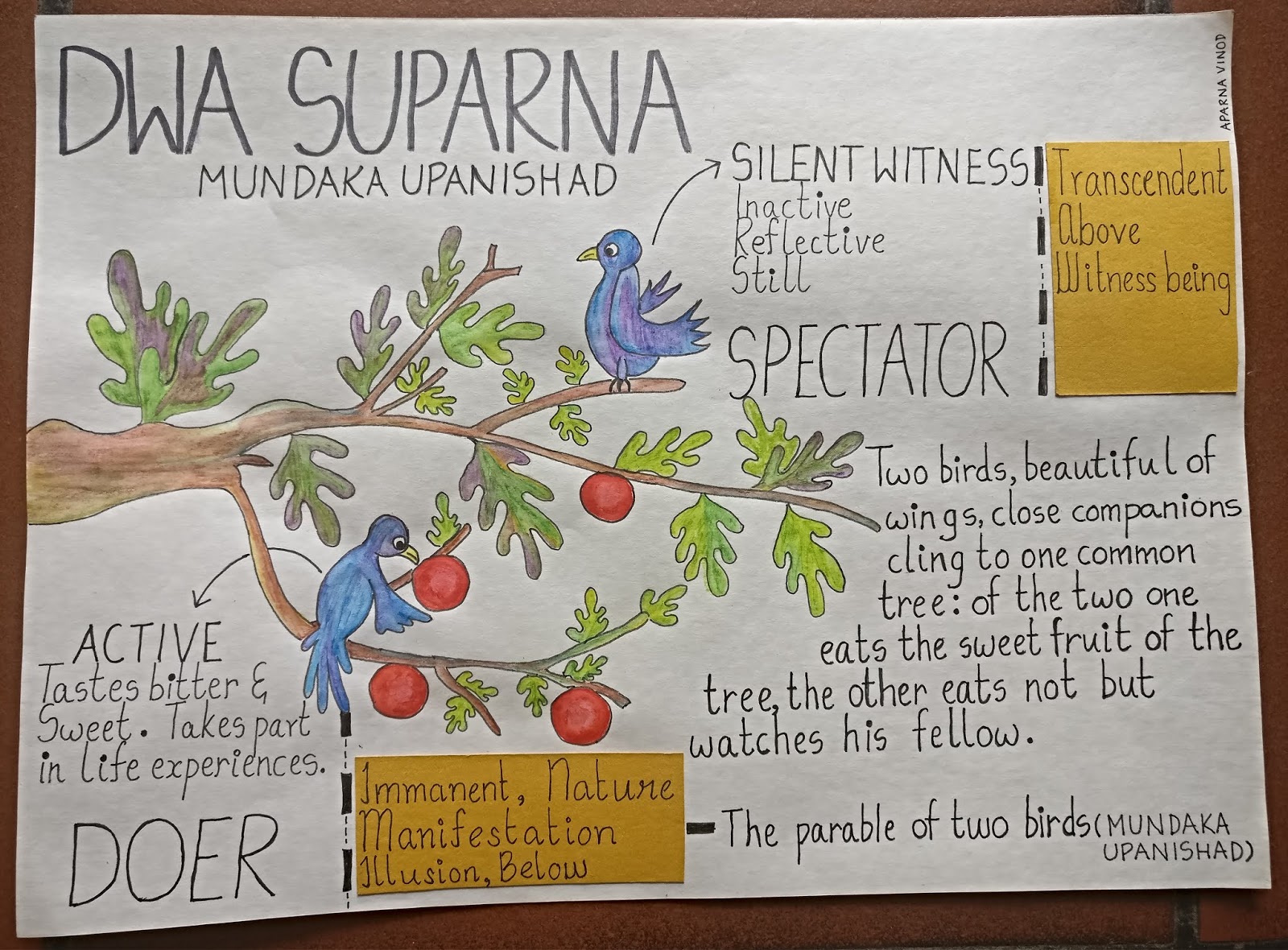The Parable Of Two Birds
On engaging with prose, poetry, and verse to iterate on the nature of my adornment, I read The Parable of the Two Birds from the Mundaka Upanishad which I found extremely fitting to the nature of my exploration. The parable describes the nature of the human mind through the metaphor of two similar birds. In Sanskrit, the verse reads as -
द्वा सुपर्णा सयुजा सखाया समानं वृक्षं परिषस्वजाते।
तयोरन्य: पिप्पलं स्वाद्वत्त्यनश्नन्नन्यो अभिचाकशीति॥
समाने वृक्षे पुरुषों निमग्नोऽनाशया शोचति मुह्यमान:।
जुष्टं यदा पश्यत्यन्यमीशमस्य महिमानमिति वीतशोक:॥
यदा पश्य: पश्यते रुक्मवर्णं कर्तारमीशं पुरुषं ब्रह्मयोनिम्।
तदा विद्वान्पुण्यपापे विधूय निरंजन: परमं साम्यमुपैति॥
Aurobindo translates the original verses of this parable as -
“Two birds, beautiful of wings, close companions, cling to one common tree: of the two one eats the sweet fruit of the tree, the other eats not but watches his fellow. The soul is the bird that sits immersed on the common tree; but because he is not lord he is bewildered and has sorrow. But when he sees that others who is the Lord and the beloved, he knows that all is His greatness and his sorrow passes away from him. When, a seer, he sees the Golden-hued, the maker, the Lord, the Spirit who is the source of Brahman, then he becomes the knower and shakes from his wings sin and virtue; pure of all stain he reaches the supreme identity.”
The two-bird parable is, in fact, Vedic in its origin, the first shloka actually belongs to the Rig Veda itself. (I: 164:20) The complete description as given there is as follows :
“Two birds with fair wings, knit with bonds of friendship, in the same sheltering tree have found a refuge. One of the twain eats the sweet Fig-tree’s fruitage; the other eating not regardeth only. Where those fine Birds hymn ceaselessly their portion of life eternal, and the sacred synods, there is the Universe’s mighty Keeper who, wise, hath entered into me the simple. The tree whereon the fine Birds eat the sweetness, where they all rest and procreate their offspring, upon its top they say the fig is luscious: none gaineth who knoweth not the father.”
The parable describes two birds who sit on the same bough, while the bird on the lower branch relishes the joys of the ripened fruit, the bird on the branch above derives its pleasure from being a silent witness and looks on. The two birds in this story reveal the 2 species of the soul. Suparna (dual) describes the active and passive nature of the human spirit. These two birds are intimate parts of our own secret being. The Bird which is the Spectator / Witness widens our vision to external sight. The Active / Doer bird experiences the pleasures and rewards of seeing and knowing.
Below is my visual interpretation of the parable based on the many readings that I engaged with -
 |
| Visual consolidation of the varied interpretations of the parable of the two birds. |
The parable of The Two Birds has been interpreted by many thinkers.
Rabindranath Tagore identifies the relationship of the two birds with each other as that of one of the infinite being and the finite self. Tagore says that “Reality reveals itself in the emotional and imaginative background of our mind. We feel it and therefore we know it. This feeling itself is a feeling of pure delight, making even a tragic drama enjoyable. We see a thing because it belongs to itself and not to a class which we can only know; we see it, we feel it, it becomes vivid. In that sense, it is the “emotional and imaginative background of our mind” which would give to the object its true soul of reality. If we have to push the reasoning farther then we would enter, through the doors of aesthesis, the very domain of Maya itself, Maya that is a kind of conceptively creative power of imagination.”
Amal Kiran, identifies establishes through his own interpretation of the parable the notion of, “the eye behind the eye".
Nolini Kanta Gupta identifies the transcendent and the immanent as different forms of the same reality, performing different functions, by standing on different levels. He believes that the bird below is not a vain image or a mere reflection but a manifestation of the reality above. Both these positions are real, they only function differently.
This parable aptly fits into the nature of my practice for mastery. The Active State of masking / adorning is where I will draw my experiences from, these experiences will be reflected upon through the action of “Witnessing the Self”. Upon viewing my practice for mastery through this new lens I was able to create a blueprint of what my adornment should achieve.
 |
| Blueprint of what the adornment should keep in mind. |
My adornment and what I want my audience to experience in my workshop will be developed with these factors in mind. I see the observations from my primary research at the sites of Koodiyattam and Theyyam lending their wisdom towards the physical creation of the adornment, and in planning the act for the transfer of experience.
I am also fascinated at how this study has progressed, almost like a meandering river it has shifted to embrace new shores 'rather' seamlessly. I decided to map the movement until now on a timeline to see how ideas have been developed, integrated and left behind.
 |
| Timeline of study thus far < click to enlarge > |
Secondary Research -
1) http://savitri.in/blogs/light-of-supreme/the-parable-of-two-birds
2) http://poetry.yoexpert.com/reading-studying-poems/what-are-the-hindu-influences-on-ts-eliot-s-%22waste-955.html
3) http://ykjanaki.blogspot.com/2015/07/maya-or-illusion.html
4)http://www.ramakrishnavivekananda.info/vivekananda/volume_2/jnana-yoga/maya_and_illusion.htm
4) The Way of the Sufi - Idreis Shah - 1968
Comments
Post a Comment